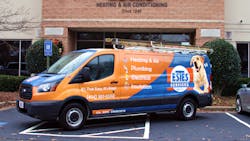Company: Estes Services, Atlanta
Operation: Heating, air conditioning and plumbing installation and service provider for residential and commercial clients. Established in 1949, the current fleet of 95 company vehicles consists mostly of Class 1-3 vans, pickups and chassis cabs upfit with service bodies as well as six heavy trucks requiring CDLs.
Problem: Around the latter half of 2015, the leadership at Estes Services began to notice an increase in collisions and a "murmur" of negative feedback from other drivers on the road. Being an HVAC company with heavily branded vehicles showing phone numbers, the company looks for and processes that feedback.
Estes first set up a basic driver scorecard system based on GPS info, which could detect and show things like speeding, hard braking and hard acceleration. But employees' first skillset is whatever the discipline—plumbing, HVAC or electrical work—with driving being a secondary function, and there are labor shortages in all those disciplines.
"We can't afford to just say, 'You do a great job, but you drive our vehicles recklessly so we're just going to move on to the next guy,'" explained Joel Heller, team leader for the residential side of the business. The scorecard approach met with only mild success, he said, and found the most traction with employees who were already the better drivers.
So 2016 started off on the wrong foot for Estes, which was informed then that its insurance coverage might not be renewed or the company would face very steep increases due to too many accidents that were attributable to Estes drivers. There had been 17 such collisions in 2015.
Solution: The company had to shop among other insurance carriers for one that would offer more help finding a solution, and another insurer suggested an in-vehicle video system or Cellcontrol, an application-based product designed to prevent distracted driving.
The driver-facing video option was both expensive and deemed too invasive for the company, and Estes decided to go with Cellcontrol. Heller installed the product first in his personal vehicle to test it out. "I was just blown away," he told Fleet Owner. "I realized very quickly how dangerous of a driver I was, how distracted I was. It was really quite sobering."
Cellcontrol allows the customer or employer to configure what a smartphone or other mobile device can do in a moving vehicle, and it works with Apple or Android devices. It can function as an app-only product or be paired with a solar-recharging, battery-powered device that sticks onto the vehicle's windshield and triggers the Cellcontrol app so it's working only when the smartphone or mobile device is within the vehicle.
In either case, when vehicle motion is detected, the app enforces the policy that's been set. For example, an employer can configure Cellcontrol to disallow email, SMS messaging and app use on the mobile device and allow only hands-free calls and GPS functionality—and in the that latter case, disallow setting or manipulating the GPS—whenever the vehicle is moving. An autoreply message can be set for text messages to let the sender know the recipient is driving and will respond when it's safe. Beeps or other message notifications are suppressed and the mobile device's touchscreen won't work.
Estes chose to use the proximity-sensing trigger hardware to engage Cellcontrol only when devices are being used in its fleet vehicles. And the policy is clear: Cellcontrol must be installed on company phones as well as any personal phones or mobile devices that are brought into the workplace. But whatever the potential solution to the distracted driving-related crashes was going to be, "it could not restrict the way we do business," Heller emphasized.
Now with Cellcontrol installed on devices, Estes drivers are dispatched to a customer and must set the GPS before heading out. The customer receives a message that the Estes technician or technician team is on the way, and the Estes employees can call or send a message to let the customer know they've arrived once they get to the destination.
It worked: Estes is now back on track, with a precipitous drop in collisions. "The results speak for themselves," said Heller. "In 2015 we had 17 accidents that were attributable to Estes drivers." As of early December last year, "we had one accident attributable to an Estes driver, and there were zero damages," he added. "I can't speak highly enough of this product."
About the Author
Aaron Marsh
Aaron Marsh is a former senior editor of FleetOwner, who wrote for the publication from 2015 to 2019.
